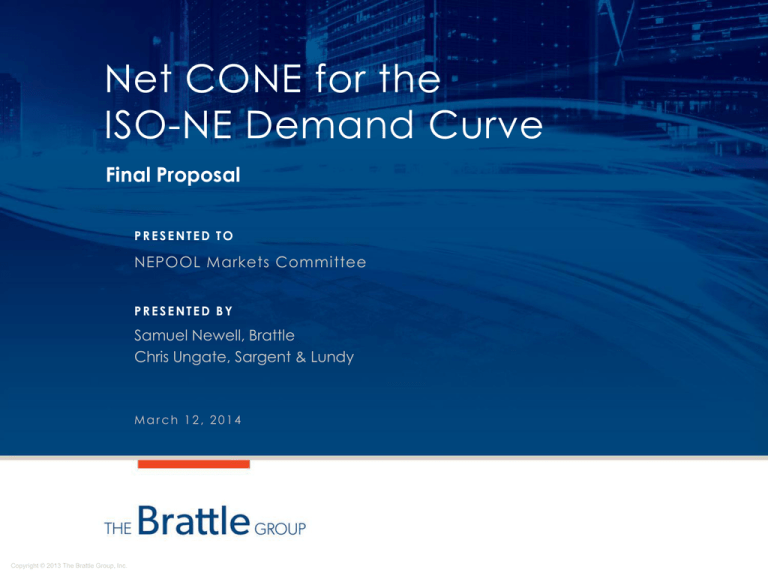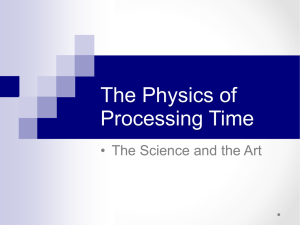Net CONE for the - ISO New England
advertisement

Net CONE for the ISO-NE Demand Curve Final Proposal PRESENTED TO NEPOOL Markets Committee PRESENTED BY Samuel Newell, Brattle Chris Ungate, Sargent & Lundy March 12, 2014 Copyright © 2013 The Brattle Group, Inc. Agenda Responses to Stakeholder Comments, and Associated Revisions ▀ ▀ ▀ ▀ ▀ ▀ ▀ Electrical Interconnection Network Upgrade Costs Oil Inventory and Other Non-Depreciable Assets CT E&AS RTR Payback CC E&AS Representative Units Electricity Forwards and PER/PFP Assumption Consideration of Lumpiness Summary of Changes Recommendation ▀ ▀ ▀ ▀ Principles for Selecting Reference Technology Review of Reference Technologies Recommended Net CONE Based on CC Locational Net CONE 1 | brattle.com Electrical Interconnection ▀ ▀ ▀ Based on stakeholder feedback, we re-visited network upgrade cost assumption Transmission costs reported in Section 15.5 Applications show that the average historical cost of network upgrades beyond the generator lead was $35/kW (2013$) We adopt the reasonable assumption that generic future projects expect to pay the same on a $/kW basis, plus $1.1m for ½ mile lead based on S&L estimate Technology Initial Costs (2013$) Final Costs (2013$) Net CONE Impact (2018$/kW-mo) LM6000 $7.1m $7.2m +0.01 LMS100 $7.1m $7.7m +0.04 Frame CT $7.1m $15.8m +0.27 CC $7.1m $26.2m +0.37 Transmission Costs from 15.5 Applications Summer Capability MW PTF Costs 2013$ PTF Costs 2013$/kW Historic Data from 15.5 Applications Bucksport 157 Westbrook 523 Rumford Power 245 Maine Independence 490 Androscoggin Energy 128 Newington Energy 521 Lake Road 726 Milford Power 485 Berkshire Power 236 AES Granite Ridge 662 ANP Bellingham 466 ANP Blackstone 441 RISE 516 Fore River 683 Mystic 8 & 9 1,396 Kendall 154 7,827 Total 264,385 17,703,195 21,264,979 29,602,411 3,050,416 1,478,685 20,458,743 12,237,377 9,954,560 37,456,491 8,964,340 24,582,786 4,992,490 22,644,863 57,578,223 3,050,094 275,284,036 2 34 87 60 24 3 28 25 42 57 19 56 10 33 41 20 35 Project Expected Costs for Future Projects (assuming same cost per KW) 173 6,100,000 LM6000 188 6,600,000 LMS100 417 14,700,000 Frame CT 715 25,100,000 CC Source: ISO-NE assembled from publicly available Section 15.5 Applications. 2 | brattle.com 35 35 35 35 Oil Inventory and Other Non-Depreciable Assets Stakeholders requested that we review how fuel inventory and working capital are accounted for in the financial model ▀ ▀ As the fuel inventory will hold residual value at the end of the economic life, we credited back to the capital costs the present value of the fuel inventory in 2038 based on long-term EIA escalation rates (+2.4%/year) Relatedly, we updated our calculation of depreciable costs based on accepted GAAP principles, which specifies that land, fuel inventory and working capital be considered non-depreciable Fuel Credit Impact ($/kW-mo) Non-Depreciable Assets Impact ($/kW-mo) Total Net CONE Impact ($/kW-mo) LM6000 -0.05 +0.09 +0.04 LMS100 -0.06 +0.09 +0.03 Frame CT -0.06 +0.07 +0.01 CC -0.04 +0.05 +0.01 Technology 3 | brattle.com Real-Time Reserve Charge-Backs and Other E&AS Adjustments to CTs Real-Time Reserve Charge-Backs: To better estimate CT E&AS revenues, we incorporated data from ISO-NE on forward reserve obligation charges ▀ ▀ ▀ Portfolios with FRM will receive real-time reserve revenues that will later be charged back Using only asset-specific market settlement data over-estimates CT E&AS as the obligation charges occur after the settlement at the portfolio level Adding ISO-NE’s portfolio-level charge-back data reduces the CT E&AS by $0.13/kW-mo Heat Rates: We adjusted fuel costs for the Frame CT and LMS100 based on their heat rates relative to the LM6000 sample plants Calculation Adjustments: We adjusted our calculation of the E&AS margin across the plants in our sample from a simple average to capacity-weighted average; also we resolved a fuel cost calculation issue during our final audits of the analysis Initial E&AS ($/kW-mo) Calculation Adjustments ($/kW-mo) RTR Charge Back ($/kW-mo) Heat Rate ($/kW-mo) Net CONE Impact ($/kW-mo) LM6000 $1.95 $1.86 $1.73 $1.73 +0.22 LMS100 $1.95 $1.86 $1.73 $1.74 +0.21 Frame CT $1.95 $1.86 $1.73 $1.72 +0.23 Technology 4 | brattle.com CC E&AS Representative Units Based on stakeholder feedback, we refined our approach for selecting the representative CC plants used to calculate historical E&AS revenues ▀ ▀ ▀ ▀ We received market revenue data from ISO-NE for 20 plants We removed 6 plants with average realized heat rates above 8,000 Btu/kWh We removed 6 plants with fuel costs that are not represented by Algonquin Citygates prices due to firm gas capacity, alternative sources of fuel, or plants with gas pricing based on Iroquois We removed 2 plants with different operations mode such as district heating and low CF (<20%) The remaining 6 plants have an average capacity factor of 58% and average heat rate of 7,400 Btu/kWh; the CC E&AS increases by $0.04/kW-mo due to this change Technology CC Initial E&AS ($/kW-mo) Updated Units ($/kW-mo) Net CONE Impact ($/kW-mo) $3.37 $3.41 -0.04 5 | brattle.com Forward Curves Mass Hub On-Peak Futures and Open Interest (ICE) ▀ ▀ ▀ ▀ Stakeholders requested futures data be used even if volume is thin We show Open Interest for ICE, which expresses the amount of forward contracts actually doing daily mark-to-market settlement on these prices We also compared to other sources available (NYMEX, ICE, Platts), which are in close agreement We will use ICE data in E&AS analysis instead of previous average of NYMEX and OTC as it more often used and is publicly available Initial E&AS ($/kW-mo) Final E&AS ($/kW-mo) Net CONE Impact ($/kW-mo) LM6000 $1.73 $1.67 +0.06 LMS100 $1.74 $1.69 +0.05 Frame CT $1.72 $1.66 +0.06 CC $3.41 $3.33 +0.08 Technology Mass Hub On-Peak Futures (All Sources) Sources: See appendix. 6 | brattle.com H Value for PER/PFP Estimates ▀ Stakeholders were concerned that assuming H = 10.9 for estimating PER and PFP is inconsistent with the electricity futures ▀ We have reviewed the implied market heat rate from the ICE forward curves for gas and electricity and agree that the lowest H case (H = 5.8) is a better assumption for our analysis ▀ At H = 5.8, the PER deduction will be $0.43/kW-mo and the PFP payment will be $0.06/kW-mo; this contributes $0.37 to Net CONE, which is $0.41/kW-mo less than the initial analysis ICE Futures and Implied Market Heat Rates Year Gas (ACG) ($/MMBtu) Annual July/Aug Historical 2010 2011 2012 2013 ICE - Futures Bal. 2014 2015 2016 2017 2018 2019 On-Peak Electric (Mass Hub) ($/MWh) Annual July/Aug On-Peak MHR (btu/kWh) Annual July/Aug $5.32 $5.05 $3.96 $7.04 $4.93 $4.92 $3.62 $4.12 $56.35 $53.00 $41.67 $65.63 $72.45 $60.46 $49.59 $53.59 10,598 10,496 10,511 9,327 14,709 12,291 13,688 13,012 $6.91 $7.47 $6.76 $6.33 $6.40 $6.51 $4.72 $4.37 $4.14 $4.25 $4.25 $4.38 $72.89 $71.84 $63.26 $53.58 $52.68 $54.08 $67.75 $58.65 $56.88 $50.33 $48.78 $52.53 10,553 9,614 9,351 8,465 8,229 8,304 14,352 13,409 13,754 11,838 11,467 12,002 Sources and Notes: ICE futures were obtained from www.theice.com. Trades are averaged from Feb 20 to Feb 28, 2014 7 | brattle.com Why Lumpiness Should Not Add to Net CONE ▀ ▀ ▀ The demand curve was designed so that Net CONE is the long-term average prices an entrant can expect, not their entry price Our curve design and simulations are consistent with lumpiness and other sources of volatility making entry more likely when P > Net CONE, at the higher end of our price distributions Consider a simple example where a 600 MW unit enters at point A and clears with 600 MW overhang (worst case for lumpiness); with 300 MW/yr load growth, the next auction clears about 300 MW to the right, at point B. The following auction adds 300 MW load, so we’re back at point A and the cycle repeats − The entrant earns Net CONE on average, and the curve achieves the reliability objectives of 1-in-10, with average quantity at about 1% above NICR (addressing reliability asymmetry) − If instead, we moved the curve up so the price at NICR + 1% were the entry price (pt. C) rather than Net CONE, we’d over-procure, with an average reserve margin at D 8 | brattle.com Summary of Impacts on Net CONE Adjustments CC Feb 27 Values $11.71 $8.95 $17.85 $20.60 Added Network Upgrades Costs +0.37 +0.27 +0.04 +0.01 Oil Inventory and Non-Depreciable Assets +0.01 +0.01 +0.03 +0.04 Updated CC E&AS Representative Units -0.04 --- --- --- --- +0.23 +0.21 +0.22 Substituted ICE Futures +0.09 +0.06 +0.05 +0.06 Reduced H to 5.8 -0.41 -0.41 -0.41 -0.41 Removed Lumpiness -0.64 -0.64 -0.64 -0.64 $11.08 $8.47 $17.13 $19.88 Adjusted CT E&AS for Payback and HR Updated Values Frame CT LMS100 LM6000 9 | brattle.com Agenda Responses to Stakeholder Comments, and Associated Revisions ▀ ▀ ▀ ▀ ▀ ▀ ▀ Electrical Interconnection Network Upgrade Costs Oil Inventory and Other Non-Depreciable Assets CT E&AS RTR Payback CC E&AS Representative Units Electricity Futures and PER/PFP Assumption Consideration of Lumpiness Summary of Changes Recommendation ▀ ▀ ▀ ▀ Principles for Selecting Reference Technology Review of Reference Technologies Recommended Net CONE Based on CC Locational Net CONE 10 | brattle.com Principles for Selecting a Reference Technology Objective ▀ Estimate Net CONE that supports prices that are on a long-term average basis just high enough to attract sufficient new investment to meet resource adequacy objectives Criteria for selecting the Reference Technology to meet the objective ▀ ▀ ▀ Reliably able to help meet load − Complies with all environmental regulations − Dispatchable technology that could be available to generate whenever capacity is scarce Likely to be economic for merchant entry as part of long-term equilibrium − Demonstrated commercial interest by merchant developers, as evidenced by projects recently completed, under construction, or in the queue in New England or the rest of U.S. − Estimated Net CONE is not so high as to make it implausible that the technology would be part of the long-term mix of resources entering the market − Available as standardized, utility-scale commercial plants without inherent constraints on the amount that could enter Can estimate Net CONE with low uncertainty − Cost estimates have less uncertainty, based on established, standardized technologies − E&AS estimates have less uncertainty relative to other technologies Additional considerations ▀ Several technologies might be economic in a long-term equilibrium, with the same long-term average Net CONE, even if not currently economic due to temporary market conditions − − It is important not to switch reference technologies back and forth over time, particularly not in pursuit of the technology whose Net CONE is temporarily lowest, as doing so will tend to under-procure If multiple technologies meet the criteria, taking an average of their Net CONEs could help stabilize market outcomes and 11 | brattle.com reduce the risk of estimation errors Review of Reference Technologies Criteria: 1. Reliably able to help meet load during scarcity Meets Environ. Regulations 2x0 LMS100 188 MW 2. Likely economic 3. Estimate with limited uncertainty Dispatchable Recently Built or Proposed Net CONE Estimate Accuracy of Capital and FOM Cost Estimates Accuracy of E&AS Estimate Yes Yes Limited $17.13/ kW-mo Well established technology Similar magnitude, uncertainties exist 2x0 Frame CT 417 MW Yes Yes Very limited $8.47/ kW-mo Well established technology, but less experience with SCR Similar magnitude, uncertainties exist 2x1 CC 715 MW Yes Yes Numerous $11.08/ kW-mo Well established technology Similar magnitude, uncertainties exist Technology 12 | brattle.com Net CONE Recommendation We recommend the 2x1 CC as the Reference Technology with Net CONE at $11.08/kW-mo ▀ ▀ ▀ ▀ CCs are clearly part of the equilibrium mix, so how wrong could choosing it be? − Clear signals from merchant developers through past, current, and proposed projects − Near-lowest Net CONE CC Net CONE estimation uncertainty is no higher than for CTs − Most experience with technology − CC E&AS estimation uncertainty is not demonstrably higher than CTs in New England Since the Frame CT’s Net CONE is lower, choosing it could risk under-procurement if it cannot actually be built at the cost we estimated − The lack of commercial activity suggests the possibility of risks or costs that are not captured in our analysis (alternatively, perhaps the SCR capability is too new to be showing up in projects yet but will soon; also possible that CTs just aren’t as economic as CCs in places where merchants are building) − Our simulation analysis showed that the reliability risks of understating True Net CONE are much more serious than over-procurement risks of overstating True Net CONE − In an FCM market with little history of merchant entry, launching a new demand curve that might not support sufficient entry could set up the new market for failure The Aero CTs’ Net CONE is too high to be plausibly part of the economic equilibrium mix of technologies Averaging multiple reference technologies could help stabilize market outcomes and reduce the risk of estimation errors; however, we recommend only the CC here ▀ The reasons we identified for not 100% relying on turbines in ISO-NE suggest not relying on them 50% either 13 | brattle.com Locational Net CONE CC CONE for NEMA/Boston is only slightly higher than rest-of-pool (ROP) ▀ ▀ Assumed the plant would be located in Lowell, MA Modified the ROP analysis based on labor and land costs, resulting in only a $0.21/kW-mo increase in CONE Connecticut CONE would be even closer to ROP due to labor rates even closer to ROP’s (based on Middletown/Meriden/Bristol/New Britain/New Haven), but didn’t quantify it precisely Energy prices have been pretty uniform across ISO-NE Overall, the differences appear to small for us to recommend differentiating the Net CONE value across New England 14 | brattle.com Appendix 15 | brattle.com Sources for Forward Curves ICE: Obtained from www.theice.com NYMEX: Obtained from Ventyx Velocity Suite OTC: Compiled by OTC Global Holdings and downloaded from SNL Financial Platts: Purchased on March 4, 2014 Note: All futures were traded as of Feb 27, 2014, except for Platts, which was traded on March 3, 2014 16 | brattle.com





